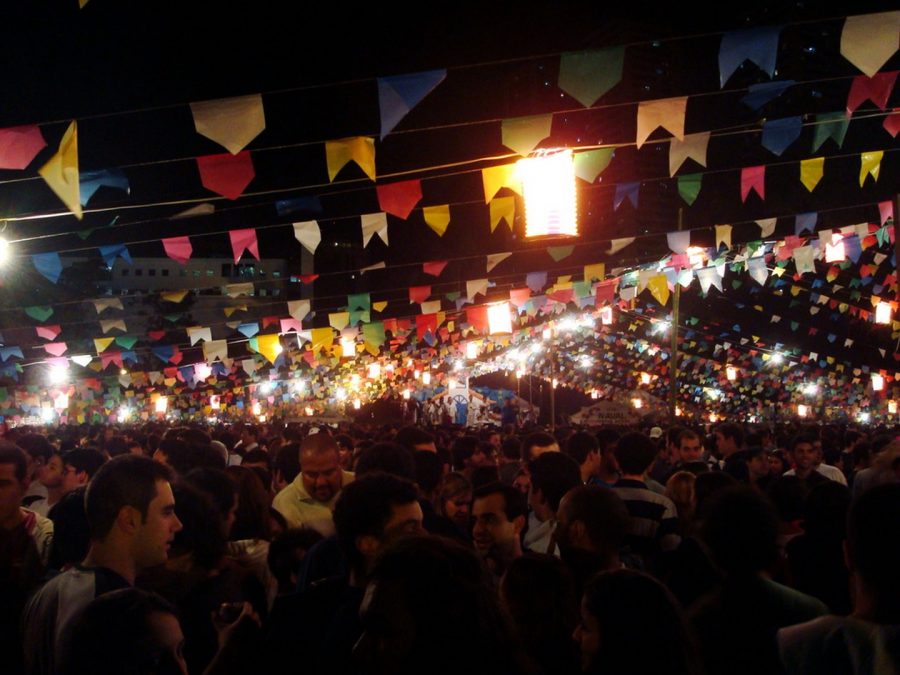Celebrations Around the World: Brazil
January 24, 2021
Brazil has lots of festivals and celebrations, but we are going to focus on Festa Junina. It is celebrated all over Brazil for the whole month of June. It celebrates Saint John the Baptist, which gave it the other name of Festo de São João. It celebrates rural life with typical clothes, food, and dances inside a big tent. It is huge and everyone loves it.
Festa Junina was a Catholic tradition introduced to Brazil during the country’s colonization by Portugal. It’s based on European Midsummer Festivities. These usually celebrate harvest and saints like Saint Anthony or Saint John The Baptist. The emphasis of Festa Junina is based on large social gatherings, drinking, eating, and dancing despite its religious founding. It has quite a bit of history to it.
All of Brazil celebrates the festival, but it is a little different in varying areas. It starts with Brazil’s winter and lasts throughout June. In some areas, especially north and northeast, it continues to July. Major cities have bigger celebrations in buildings with colorful flags and checkered tablecloths. You can find a smaller celebration in almost every neighborhood. These celebrations can be held anywhere. Northeast of Brazil the celebrations can rival those of the Carnival. So everywhere you go it is a little different.
The festival is celebrated usually in a specific way. It celebrates the harvest, so the events usually are very rural and try to represent the countryside. Dancing is a big part of it. The dancing is centered around the traditional dance called quadrilha. Schools may host an event, so that the kids’ families get to watch them perform. There may be games like a three-legged race. There might even be a bonfire, though those are more common in the south. There are a lot of things going on during the festival.
The food and drinks are also important. It is usually comforting and from local ingredients as you would expect rural food to be. Typical foods include corn cakes made from finely ground rice or corn flour called bolo de fubà. There is usually carua, which is corn, peanuts, and condensed milk then they top it with cinnamon. Shredded milk with condensed milk and butter is cocada de colher. Pè-de-moleque is a sweet treat consisting of hard toffee and peanuts. There is also a candy made out of crushed peanuts called pacoca. One of the typical drinks is quentão which is a hot drink with cachaça, ginger, sugar, cloves, and cinnamon. The other popular drink is vinho quente which is similar to mulled wine. The food and drinks are some of the best parts of the festival.
The dancing and music are a big attraction for everyone. The dance most associated with Festa Junina is the quadrilha, a type of square dancing in which couples dress up as caipiras or people who live in rural or remote areas of Brazil. The women typically wear makeup and paint freckles on their faces while men may paint on a mustache and a goatee. The music with the dancing is forró, a music genre that is more common in the northeast of Brazil. It’s played with an accordion, a zabumba, and a triangle and it is an uplifting, fast-paced genre of music. It’s popular throughout Brazil, especially during the Festa Junina. The people of Brazil put a lot of work into the festival and dancing.
Festa Junina is the second biggest festival in Brazil with Carnival as the first. It has people dancing the traditional dance of quadrilha. The food is comforting and local. It has religious origins and is for all ages. Festa Junina is a big part of Brazil and is full of joy. Most of this information is from Culture Tip and if you want more information I would recommend this website.






















































































































































lily pliske • Jan 25, 2021 at 10:31 am
this was a good read and it kept me entertained the whole time.